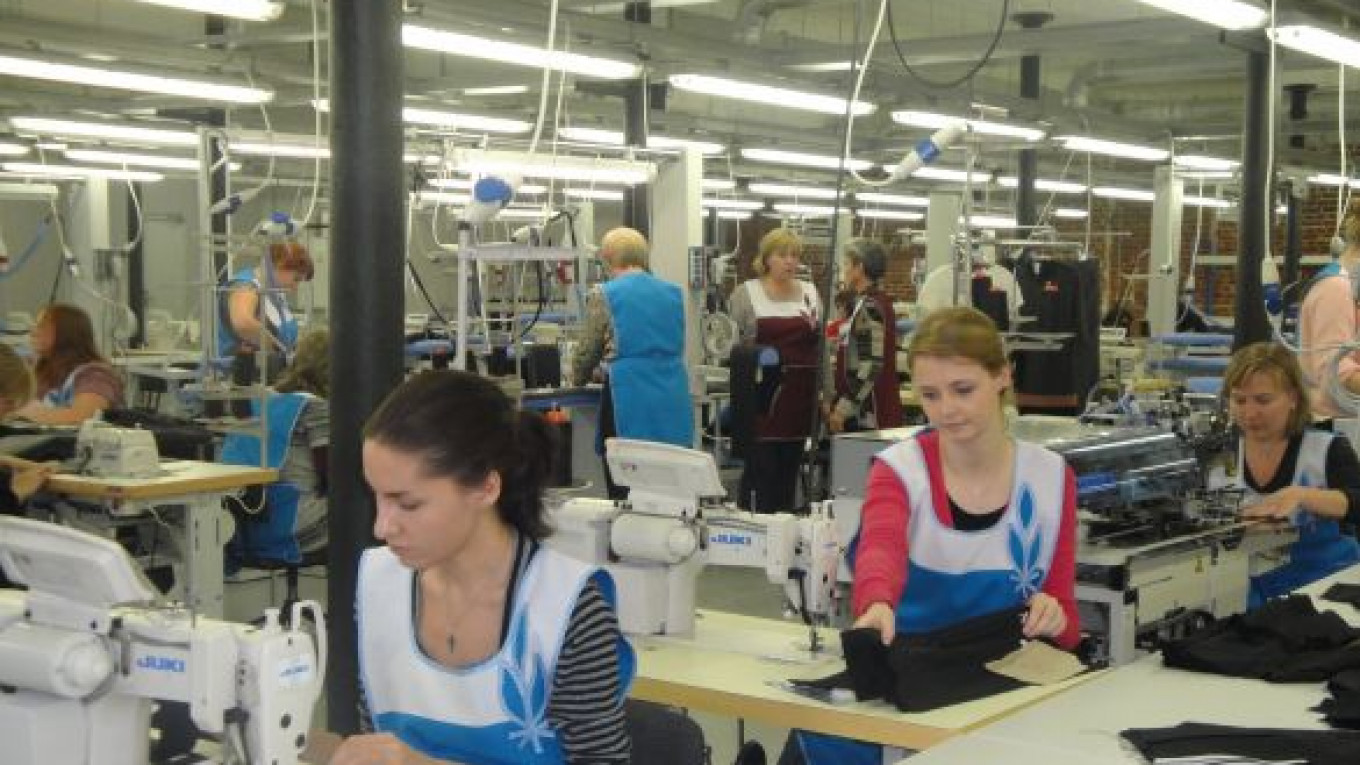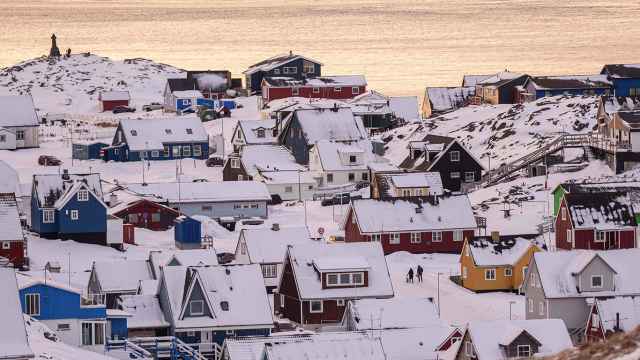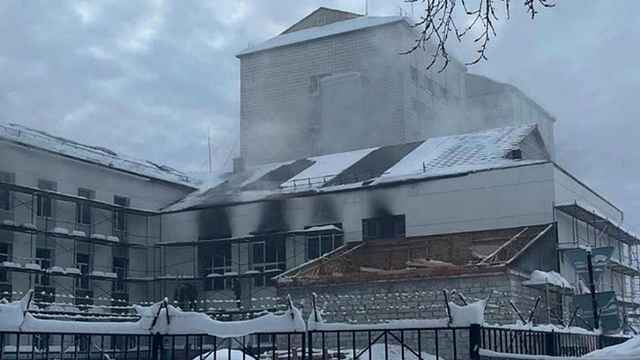While some Russians express patriotism by screaming in the stands at Luzhniki stadium, Russian clothing designers, who are increasingly adopting domestic manufacturing, find that the sound of high heels clicking down a runway is better proof of their love for the motherland.
Now in the spotlight thanks to the annual Mercedes-Benz Fashion Week in Moscow, local style-makers who have moved manufacturing back to their home country say the strategy is not only patriotic but also makes good business sense.
"It is not a publicity move," said Olga Feldt, general director of Kira Plastinina Style.
The company opened a manufacturing plant in the Moscow region last week as part of the effort to move production from Asia to Russia.
Kira Plastinina joins a list of fashion houses moving out of China as costs there rise. The exodus may be just what is needed to revive Russia's decaying textiles industry, but the initial investment in local plants and specialized staff is still so high that it is more attractive to set up production in nearby Eastern European countries.
Two old women and a child huddled near the entrance of a brick building in the small city of Ozyory in the Moscow region on a gray October morning. Despite their rain gear and lowered gaze, it was still possible to catch the look of awe in their eyes.
"We were just inside for a tour," one of the old women informed the other. "It is incredible."
The women had something to be surprised about. On this day, the textile plant, which has an almost 200-year history but has been closed for more than a decade, was working again.
Russian designer Kira Plastinina invested 150 million rubles ($4.8 million) to open the first production line at the Ozyory factory. Her company is planning to double this amount by investing in a second line later.
The textile factory will produce 325,000 units of clothing per year, which will cover 100 percent of Plastinina's premium brand and 15 percent of her mass-produced clothing line for girls ages 14 to 25, although this figure is expected to increase to 40 percent when the second production line starts.
The brand's clothes were previously made in China.
Company managers insist that the move is a logical business step. Revenues, which will reach 4.5 billion rubles in 2012, are expected to increase 40 percent to 5.5 billion rubles in 2013, largely as a result of the company's transfer of production to Russia, Plastinina said.
"Opening production in the Moscow region not far from the central office will allow us to simplify the path that a collection has to go through from the design phase to the time when the finished product shows up in the style studio," Plastinina said. "Basically, we can react to the demands of our customers quicker, and we can quickly adapt to world trends."
Plastinina calculated that the company would decrease its production cycle from nine to two months by making the clothes in Russia.
As expected, labor costs have increased. The company paid the Chinese workers $100 to $150 per month, whereas workers in Ozyory receive a $906 monthly wage. However, Plastinina said the price for the clothes will stay the same because the Russian factory will use technology more effectively.
Local Advantages
Kira Plastinina is not the only Russian designer who wants to make clothes locally. Others, including Masha Tsigal and Alexander Terekhov, have ateliers in Moscow and argue that this makes good business sense.
"It is convenient to produce clothes in Moscow," Tsigal said. "You can always control the process. Everything is right in front of your eyes,"
Valentin Yudashkin, one of the country's most prominent fashion designers, said that making clothes in Europe allows him to quickly supply his European boutiques and save on transportation costs.
Yudashkin, who manufactures his main collections in Moscow, is looking to expand his Russian production capacity. He visited Ingushetia in June 2011 to discuss plans for creating a large textile factory in the republic. His company is currently working on the details of the plan and has initiated its first phase.
From his humble beginnings in Ivanovo, a traditional textile-manufacturing city, to his 30-year reign as the head of Russia's oldest fashion house, Vyacheslav Zaitsev has become a symbol of the country's fashion industry. When his new collection debuted on the runways Thursday, it once again illustrated traditional Russian taste.
But Zaitsev's clothes, though flourishing with local motifs, are not always made in-country.
The designer supports local manufacturers as much as he can, but he can't move his production to Russia completely because the country doesn't have the technology, raw materials or staff that he needs, said Nikolai Golovin, deputy general director of the Slava Zaitsev fashion house.
Zaitsev makes high-fashion items in his Moscow atelier, but only 10 to 15 percent of clothes in his mass-produced line are manufactured in Russia. The rest are made in Turkey and China.
"We are not conceited," Golovin said. "We would be happy to produce in Russia, but we can't."
Hurdles Remain
Men's suits from the Slava Zaitsev line are made in Germany since Russian factories don't have the technology to sew the complex designs. Even if the technology does exist here, workers often don't know how to operate it, Golovin said.
Although Kira Plastinina picked Ozyory as her manufacturing base because the textile city already had specialists, the company still has to provide its own training courses for seamstresses to get staff up to speed.
Yudashkin has plans to launch education courses in Ingushetia in the near future to prepare staff before his textile factory is opened.
"[This program] aims to popularize and raise of the prestige of the profession as well as prepare highly qualified staff," Yudashkin said.
Even when the designers move some production to Russia, it can still be more economical to make certain clothing lines abroad. Usually, the lower-volume, high-fashion clothes are made in Russia because producing them in China is equally expensive. Foreign factories handle the simpler mass orders, which is the case with Plastinina's youth line, which is still largely produced in China and Yudashkin's jeans manufacturing in Hong Kong and Turkey.
Large orders are also still mostly sent to China because Russian factories don't have the same capacity. Bosco, which makes uniforms for the Russian Olympic team, produces most of its items in Asia, while the more intricate items are made in Europe.
"Unfortunately, the sizes of the orders and the deadlines by which they must be completed are such that European and domestic production facilities don't have the capacity, so the less complex items we sew in Asia," a Bosco representative said.
But China's developed industrial base may indirectly help Russian manufactures. Some designers are forced to sew their clothes at Russian plants because their orders are not large enough to meet Chinese minimum volumes.
Eastern Europe an Option
Design duo Alisa Ruban and her sister Yulia said they are planning to move production out of Russia this year, but China is not an option because their orders for about 1,000 clothing units are too small.
"We don't plan to produce in Asia. They need very large orders, and the prices are good only if you file such large orders. Moreover, the quality is not great," Alisa Ruban said. She added that they are looking instead at setting up production in Serbia, Latvia or Lithuania.
While some fashion designers struggle to ramp up domestic production, the Russian government is staking the revival of the textile industry on something far less stylish: military and school uniforms.
The Economic Development Ministry is proposing a requirement that military uniforms be locally made, while the Industry and Trade Ministry is contemplating reinstating a mandatory requirement for school uniforms as a way to keep local textile manufacturers busy – and make sure that patriotic Russians still have something to scream about.
Related articles:
A Message from The Moscow Times:
Dear readers,
We are facing unprecedented challenges. Russia's Prosecutor General's Office has designated The Moscow Times as an "undesirable" organization, criminalizing our work and putting our staff at risk of prosecution. This follows our earlier unjust labeling as a "foreign agent."
These actions are direct attempts to silence independent journalism in Russia. The authorities claim our work "discredits the decisions of the Russian leadership." We see things differently: we strive to provide accurate, unbiased reporting on Russia.
We, the journalists of The Moscow Times, refuse to be silenced. But to continue our work, we need your help.
Your support, no matter how small, makes a world of difference. If you can, please support us monthly starting from just $2. It's quick to set up, and every contribution makes a significant impact.
By supporting The Moscow Times, you're defending open, independent journalism in the face of repression. Thank you for standing with us.
Remind me later.






